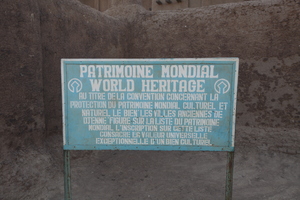Djenné

The Old Towns of Djenné comprise the city of Djenné with its typical architecture and the archeological sites of four pre-Islamic towns.
Djenné, situated on an island in the Bani-river, was a prospering city from the 14th til the 16th century as an important station on the Trans-Sahara route. Its Grand Mosque, originally dating from the 13th century, fell into decay but was rebuilt in the early 20th century. It is replastered yearly in a festival-like event in Spring. The associated archeological sites are Djenné-Djeno, Hambarketolo, Tonomba and Kaniana. They hold remains of traditional brick structures and have produced a wealth of terra cotta artifacts and metal.
Community Perspective: the Old Town is appreciated for its photogenic mud-covered mosque and old two-story houses. Solivagant also visited the archeological site of Djenné-Djeno.
Map of Djenné
Community Reviews
Solivagant

The UNESCO web site is even less informative about the inscribed elements of Djenne than it usually is and I have not even managed to access the “Advisory Body Evaluation”. The title is for the “Old TownS” (plural) but exactly what this includes is not made clear. The famous mud-covered mosque is clearly covered together with the extant surrounding townscape. Whether however the older town of Jenne-Jeno a few kilometres away, and now just an archaeological site, is included I don’t know for certain (though I am reasonably sure it is). Yet this is the more important site historically and it is certainly not on Mali’s Tentative list as a separate entry. It’s most important period straddles AD400 – AD1300 after which the newly converted population moved the short distance to the new Islamic city of Djenne..
There is, in truth, not a lot to see at the archaeological site other than to gain an impression of its size, its walls and its many houses but, whilst you are in the area, it is worth the trip to see the site of what might well be the oldest city south of the Sahara.
As for “modern” Djenne. If you go to Mali you are unlikely to miss it so there is no need really to “sell” it as a destination. The current mosque is in fact a relatively recent building (1905) but has become an African icon. It is very photogenic from many viewpoints – primarily from the main square and the houses which line it and allow tourists upstairs for a better view but also from more distant glimpses around the town (photo). As a tourist you will not be allowed into it however – “legend” has it that this is in response to the indecent cavortings of models during the production of a Pirelli calendar a few years ago (the Mosque in Timbuctoo can still be visited by non-Muslims). The town of Djenne is an island and there are some pleasant walks and views of locals going about their business to be had. The town’s main negative when we were there a few years ago is the surprising lack of a hotel of even reasonable quality and cleanliness considering the relative popularity of the town.
Els Slots

Quite a lot of tourists visit Djenné, especially because of its famous mosque. However, the old two-storey houses in town are also very worthwhile.
When you roam around the streets, the first thing that strikes you is the stench: the preservation of this world heritage has reached so far that it is not allowed to construct modern sewerage.
Community Rating
Site Info
Site History
2016 In Danger
Due to insecurity in the area
1988 Inscribed
1981 Deferred
At Bureau - need info on protection
1980 Deferred
Site Links
Unesco Website
In the News
Connections
The site has 23 connections
Art and Architecture
Constructions
Geography
History
Religion and Belief
Timeline
Trivia
Visiting conditions
WHS on Other Lists
World Heritage Process
Visitors
53 Community Members have visited.
